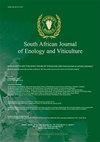波兰葡萄酒和鲜食葡萄品种初芽抗寒性的研究
IF 1.1
4区 农林科学
Q4 FOOD SCIENCE & TECHNOLOGY
引用次数: 8
摘要
本研究的目的是比较葡萄品种在田间条件下的抗寒性。继2016/2017年和2017/2018年冬季之后,对波兰中部(Skiernievice,北纬51.9627度,东经20.1666度)种植的42个葡萄酒品种和45个食用葡萄品种的葡萄藤进行了霜冻危害评估。两个冬季的最低温度分别记录在2017-01-07(-20.9°C)和2018-02-27(-20.1°C)。在评估的品种中,19个(13个酿酒葡萄品种和6个食用葡萄品种)属于葡萄品种,68个是种间或种内杂交品种。品种被分为五类不同的耐霜性,括号中给出了冷冻初生芽的比例信息:非常抗性(1.9%以下)、抗性(2%至24.9%)、中等敏感(2%至74.9%)、敏感(75%至95.9%)和非常敏感(96%以上)。葡萄酒和餐桌葡萄品种在特定类别中的数量(两个冬天的平均值)如下:非常抗性–20(葡萄酒)和10(餐桌),抗性–15和13,中等敏感–6和20,敏感–1和2。葡萄品种和种间杂交种在耐霜性方面都高度多样化。在大多数品种中,2016/2017年冬季之后的冷冻芽数量大于2017/2018年冬季之后。在葡萄中,“雷司令”、“黑皮诺”、“Chasselas Dore”(参考)和“Tauberschwarz”、“Veltliner Fruhrot Malvasier”、“Turan”、“Domina”、“Tressot Panache”、“Blue from Tychy”和“Irsai Oliver”具有很强的抗性或抗性。葡萄的其他品种是中等敏感或易感的。本文章由计算机程序翻译,如有差异,请以英文原文为准。
Cold Hardiness of Primary Buds of Wine and Table Grape Cultivars in Poland
The aim of this study was to compare the cold resistance of grapevine cultivars in field conditions. Following the winters of 2016/2017 and 2017/2018, an assessment of frost damage was carried out on the vines of 42 wine cultivars and 45 table grape cultivars grown in central Poland (Skierniewice, latitude 51.9627 N, longitude 20.1666 E). The minimum temperature for each of the two winters was recorded on 2017-01- 07 (-20.9°C) and on 2018-02-27 (-20.1°C). Among the assessed cultivars, 19 (13 wine grape cultivars and six table grape cultivars) belonged to V. vinifera species and 68 were inter- or inter-intraspecific hybrids. Cultivars were divided into five classes of different frost tolerance, with information on the proportion of primary buds frozen given in the brackets: very resistant (below 1.9%), resistant (2% to 24.9%), medium susceptible (2% to 74.9%), susceptible (75% to 95.9%) and very susceptible (above 96%). The number of wine and table grape cultivars in particular classes (mean for two winters) was as follows: very resistant – 20 (wine) and 10 (table), resistant – 15 and 13, medium susceptible – six and 20, susceptible – one and two. Both the V. vinifera cultivars and the interspecific hybrids were highly diversified in terms of frost tolerance. In most cultivars, the number of frozen buds after the winter of 2016/2017 was greater than after the winter of 2017/2018. Among V. vinifera, ‘Riesling’, ‘Pinot Noir’, ‘Chasselas Dore’ (reference) and ‘Tauberschwarz’, ‘Veltliner Fruhrot’ (‘Fruehroter Malvasier’), ‘Turan’, ‘Domina’, ‘Tressot Panache’, ‘Blue from Tychy’, and ‘Irsai Oliver’ were very resistant or resistant. Other cultivars of V. vinifera were medium susceptible or susceptible.
求助全文
通过发布文献求助,成功后即可免费获取论文全文。
去求助
来源期刊
CiteScore
2.50
自引率
7.70%
发文量
1
审稿时长
>36 weeks
期刊介绍:
The South African Journal of Enology and Viticulture (SAJEV) publishes full-length original Research Papers, Research Notes and Review Papers on all subjects related to enology and viticulture. The SAJEV does not accept articles published in, or submitted to, other journals.

 求助内容:
求助内容: 应助结果提醒方式:
应助结果提醒方式:


